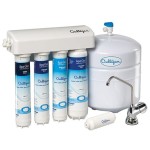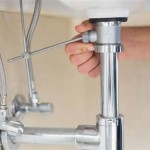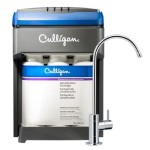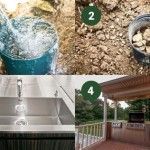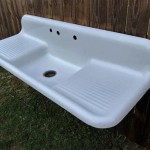Drain Parts for Kitchen Sink: Understanding the System
The kitchen sink is a vital part of any home, facilitating food preparation, cleanup, and dishwashing. While often overlooked, the drain system beneath the sink plays a crucial role in ensuring efficient, hygienic, and trouble-free operation. Understanding the components of a kitchen sink drain system is essential for homeowners who wish to perform routine maintenance, troubleshoot issues, or even undertake repairs. This article provides an overview of the various drain parts commonly found in kitchen sinks, outlining their functions and significance.
Types of Kitchen Sink Drains
Kitchen sink drain systems are typically designed with one or more distinct components, each serving a specific purpose. The most common types of drain components include:
- Strainers: These are the visible, removable parts located at the top of the sink drain. Made of metal or plastic, strainers are designed to catch food particles, hair, and other debris before they enter the drainpipe, preventing clogs and blockages.
- Drain Pipes: These are the pipes that connect the sink to the main sewer line, carrying wastewater away. They are usually made of PVC or ABS plastic, and can be either straight or curved, depending on the sink's configuration.
- P-Traps: Shaped like a “P”, these traps are essential components of the drain system. They hold a small amount of water, creating a seal that prevents sewer gases from entering the home. P-traps are usually made of PVC, ABS plastic, or metal.
- Drain Stoppers: These are mechanisms that control the flow of water from the sink. They can be manual, operated by a lever, or automatic, activated by a push button or a sensor. Drain stoppers are essential for filling the sink with water for washing or soaking dishes.
- Waste Disposals: While not strictly part of the drain system, waste disposals connect to under-sink drains. They are electrical appliances used to grind food scraps, making them easier to dispose of through the drain system, preventing clogs.
Understanding the Function of Drain Parts
Each component of the kitchen sink drain system serves a specific purpose, contributing to the overall efficiency and hygiene of the system. Here’s a breakdown of their individual roles:
- Strainers: As mentioned earlier, strainers are the first line of defense against clogs. By trapping larger debris before it enters the drainpipe, strainers significantly reduce the chances of blockages. Regular cleaning of strainers is essential for maintaining their effectiveness.
- Drain Pipes: These pipes are responsible for transporting wastewater from the sink to the main sewer line. Their smooth internal surfaces ensure efficient flow, reducing the likelihood of clogs. However, over time, grease and grime can build up inside the drainpipes, hindering water flow and requiring periodic cleaning.
- P-Traps: These traps act as a barrier, preventing the backflow of sewer gases into the home. The water trapped in the "P" forms a seal that prevents odorous gases from rising up the drainpipe. It's essential to ensure the P-trap always contains water for effective operation.
- Drain Stoppers: These mechanisms control the flow of water from the sink, allowing it to be filled for washing or soaking. They can be either manual or automatic, providing convenience and efficient water management.
- Waste Disposals: Although not directly part of the drain system, waste disposals significantly impact the efficiency of the overall system. By grinding food scraps, they minimize the risk of clogs in the drainpipe and P-trap. Proper disposal practices are crucial to avoid damaging the disposal unit or causing blockages.
Troubleshooting Common Drain Issues
Understanding the function of each drain part can assist in quickly identifying and addressing common drain issues. Here are some examples:
- Clogged Drain: A slow drain, clogged sink, or gurgling noises are often signs of a clogged drain. The culprit could be a blockage in the strainer, drainpipe, or P-trap. Utilizing a drain snake or plunger can often be effective in clearing blockages.
- Leaking Drain: A leaking drain can indicate a damaged P-trap, loose connections in the drainpipe, or worn-out drain stoppers. Inspecting the connections and replacing damaged components can rectify the leak.
- Sewer Gas Odor: A foul odor coming from the sink may indicate a faulty P-trap, allowing sewer gas to enter the home. Ensuring the P-trap contains water and checking for any leaks or broken seals can resolve this issue.
By understanding the different drain parts and their functions, homeowners can effectively maintain the health and efficiency of their kitchen sink drain system. Regular inspection, cleaning, and prompt addressing of any issues can prevent costly repairs and ensure smooth, hygienic operation of this vital household fixture.

Parts Of A Sink The Home
How To Install A Kitchen Sink Drain

Sink Drain Plumbing

Parts Of A Kitchen Sink Detailed Diagram

How To Install A Kitchen Sink Drain Diy Guide For You

Kitchen Sink Plumbing Parts

Parts Of A Sink The Ultimate Guide

110mm Drain Kit For Kitchen Sink Stainless Steel 304 Assembly Waste Strainer Aupk

Iviga 3 1 2 In Sink Opening Waste Drain Valve Brass Kitchen With Twist Handle And Overflow Outlet Vpp10 T The Home

Kitchen Sink Strainer Assembly Drain Device Set Waste Basket Sealing Lid Hose
